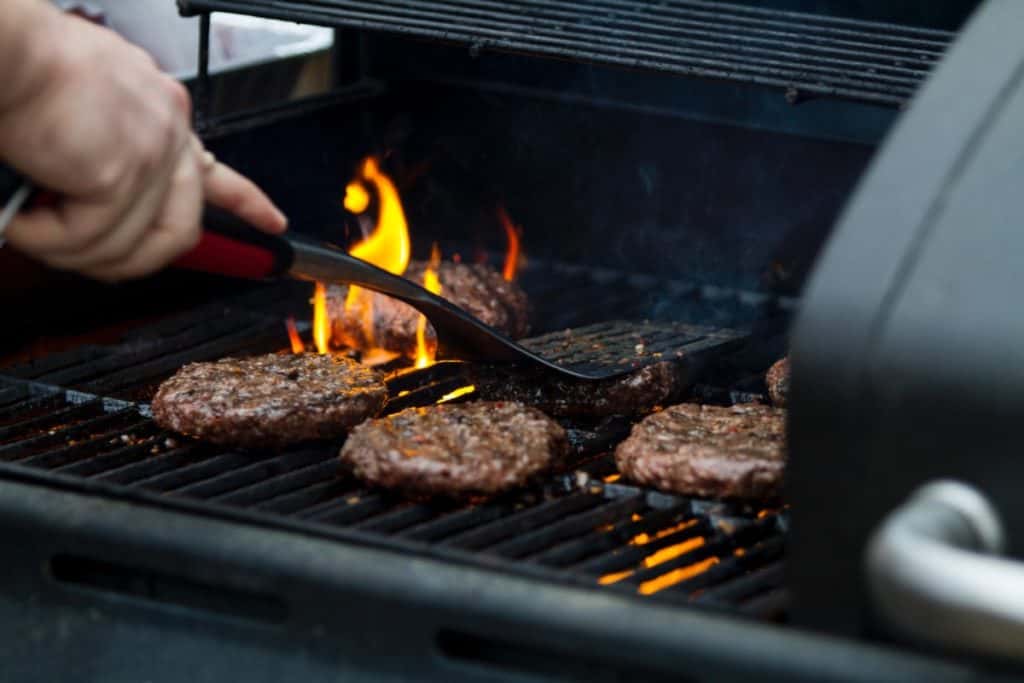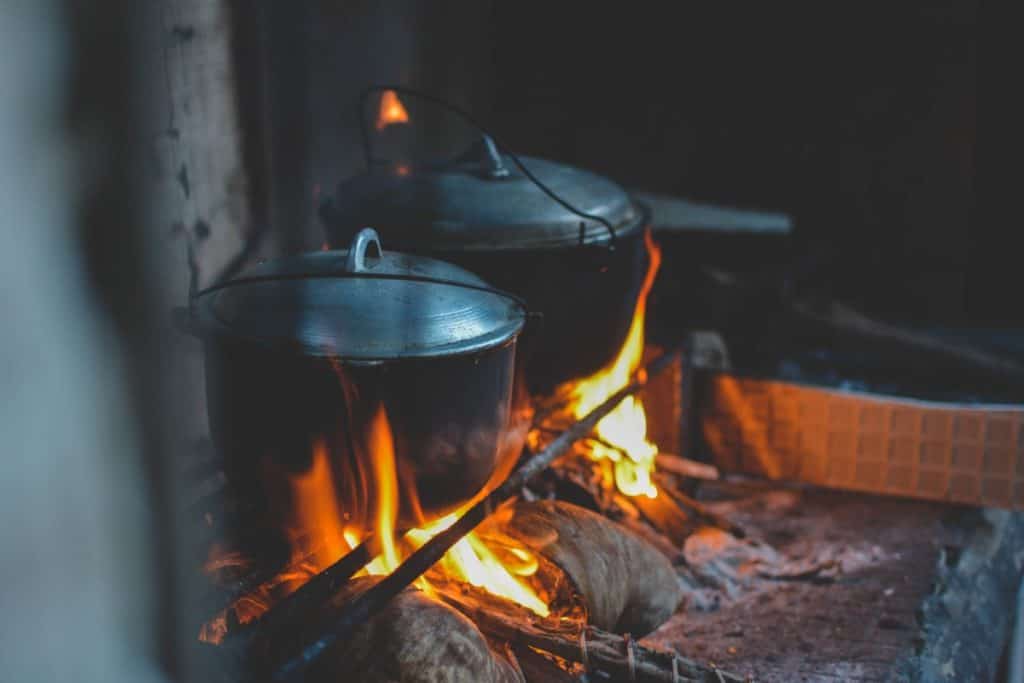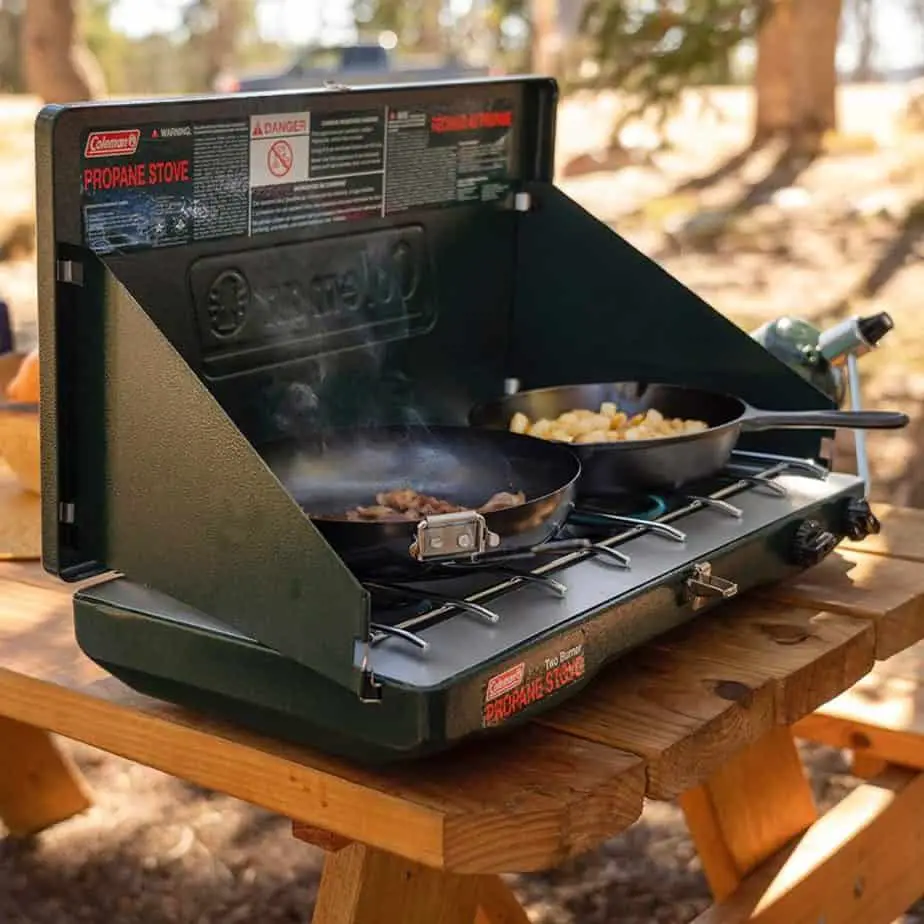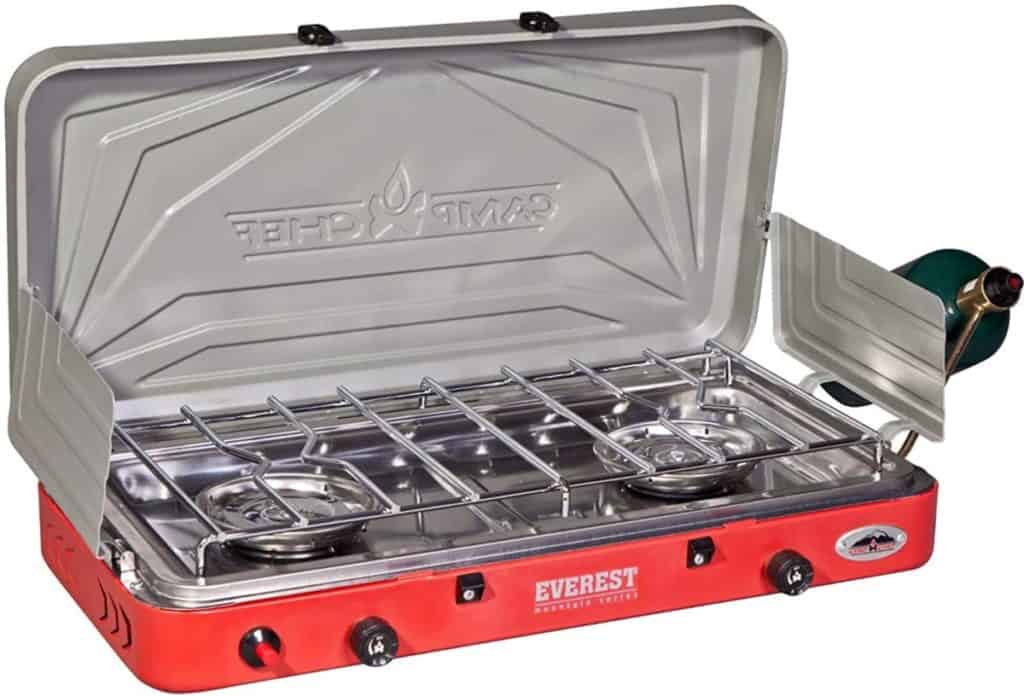If you’re experiencing a power outage, you may be wondering how you’re going to cook your next meal without electricity and modern-day appliances that make cooking a cinch. Luckily, there are several ways to prepare a meal for yourself or the whole family, as well as a number of steps you can take to be prepared for any future power outages.
What are the best ways to cook when the power is out? The best ways to cook when the power is out are by one of the following:
- Propane Stove
- Grill
- Fireplace
- Dutch Oven
- Camping Stove
- Folding Stove
- Portable Butane Stove
- Kerosene Heater
While cooking without power may not be ideal, there are several ways you can prepare a meal. Just be sure to follow any and all safety precautions as many of these options involve open flames. Keep reading to learn about the many ways you can cook with no power, a handy chart to determine food safety, some precautions to be aware of, and tips for cooking with no power.
1. Propane Stove
If you have a propane stove, then you’re already prepared to cook a meal in the event of a power outage. Propane stoves have a built-in igniter that won’t work without electricity. But, you can light them with a match. Do make sure you’re in a room that is properly ventilated to avoid carbon monoxide fumes which can be deadly.
Make sure all burners are off before you begin trying to light your stove. To light a burner with a match, hold the lit match to the burner and turn the burner knob to the lowest flame position. Once ignited, turn the burner fully on. Be very cautious as you light your burner with a match as accidents can always happen and tend to happen very quickly.
More than likely the oven will require electricity to work, so plan on not being able to use the oven during a power outage.
2. Grill

If the power is out and you’ve got some kind of grill, whether it’s coal, propane, or even solar, then you’ve got a way to prepare a hot meal for yourself or your family. The biggest perk to grilling is no matter the weather, you can still use your grill, though you may need to make some minor adjustments.
For instance, if it’s cold and snowy out when you lose power, you’ll want to bundle up before you head out to start up the grill and make sure you’re wearing heat-resistant gloves. Clear a path to your grill and remove any and all snow and ice around the grill before you get started. Grilling when it’s cold out may take some extra time, so make sure you have plenty of fuel and to always grill with the lid closed.
If you’re grilling in the rain, put on some rain gear and bring a buddy to help protect the food from the rain with an umbrella. Again, grilling in the rain may take a little longer than usual.
While grilling in the snow or rain may not be ideal, remember to never move your grill into the garage as this can produce carbon monoxide which is dangerous to inhale.
3. Fireplace

If you’re without power, but have a fireplace in your home, you can easily roast some vegetables, meats, or marshmallows for s’mores using skewers.
Before you start cooking make sure your flue is open as leaving it closed will expose you to carbon monoxide. Also, make sure there is nothing flammable sitting near the fire and that your chimney is clean; even if you only plan to sue your fireplace a couple of times a year, it’s important you stay up to date on cleaning and maintenance to ensure safety.
Don’t forget to set a pan nearby to catch any drippings, this will make clean up easy and reduce the amount of smoke produced by the fire.
4. Dutch Oven

If you have a dutch oven and a source of heat, such as a campfire, fire pit, fireplace, or grill, you can whip up a delicious meal even without power.
If you’re cooking over an open fire, first take the time to prepare your campfire and ensure you have a nice bed of hot coals. The beauty of a dutch oven is you just throw all the ingredients in the pot. Once your food is ready to cook you’ll eventually place the lid snugly on your pot, set your pot on the hot coals, then use a small scoop to place a layer of hot coals on top of the lid. Check your meal about every 10 minutes as a dutch oven tends to cook food very quickly.
5. Camping Stove
Camping stoves are portable, lightweight stoves typically used for camping trips, but can also be handy when the power goes out and you need to eat.
Most camp stoves use propane, so make sure you have enough fuel before you begin cooking. To start cooking, you’ll connect the propane to the stove, use the ignitor to light the stove, turn the know and you’re ready to cook.
If you’re interested in purchasing a camping stove, check these out:

This Coleman camping stove has two adjustable burners, wind-blocking panels, and pressure control technology for high-performance even in extreme conditions.

This camp stove has matchless ignition, a stainless steel drip tray for easy clean-up, and two burners.
6. Folding Stove
A folding stove is a small, compact stove that folds out into a mostly square box, with fuel placed under a metal grate and an area to cook on top. There are several benefits to a folding stove such as being affordable, easy to clean, and the ability to be used indoors or outdoors.
The only drawback to a folding stove is that it’s not a major source of heat. A small frying pan or small pot will work best with this stove, and the best things to cook on a folding stove are canned goods such as canned soups, chilis, and vegetables.
If a folding stove sounds like something you would like to have around in case of emergencies, here are a couple of options:
- Coghlan’s Folding Stove. This stove’s dimensions are 6.5”x6.5”x5” and will work with any type of canned fuel.
- Sterno Portable Folding Stove. This folding stove weighs less than one pound and is designed to hold 7 oz. Sterno fuel canister.
7. Portable Butane Stove

A portable butane stove is another small, compact stove that is super convenient to have around in an emergency or when the power goes out.
To use a butane stove you’ll first want to make sure the stove is off, then open the butane cartridge compartment, located the latch stove and line it up with the canister, close and lock the compartment, and lastly, turn the dial clockwise until you hear a click. You can use any pot or pan on a butane stove, just make sure what you’re cooking with isn’t larger than the stove itself.
Portable butane stoves are not to be used indoors or in a confined space. Butane stoves allow you to cook nearly anything you want on them.
8. Kerosene Heater
If you have a kerosene heater then you have a great source of heat for food during a power outage. To use a kerosene heater safely you will need to make sure you have enough fuel, keep the wick clean, and if there are any kerosene spills, you’ll need to clean them up immediately because it is a fire hazard.
When using your kerosene heater to cook, make sure the heater is several feet away from furniture, curtains, papers, clothes, and bedding. Keep in mind while using a kerosene heater that it is a constant open flame and children and/or pets should stay away. Do no touch while using, allow the heater to cool before you touch it.
To use a kerosene heater to cook, simply place your choice of pot or pan on top of the heater. A kerosene heater gets hot enough to boil water and has the ability to cook a number of things such as canned soups or vegetables, and macaroni and cheese.
If you don’t have a kerosene heater yet, check these heaters out:
- Dura Heat Indoor Kerosene Heater. This heater operates 8 – 12 hours on one tank of fuel, provides both heat and light, and the no lift heat chamber minimizes startup odor.
- Sengoku HeatMate Kerosene Heater. The Sengoku heater will continue working up to 14 hours with one fill, features automatic shutoff, and measures 15”x15”x23”.
What to Cook During a Power Outage
Here are a few breakfast, lunch, dinner, and snack ideas that can be made during a power outage.
Breakfast
- Yogurt parfait. Yogurt parfaits are an excellent way to use up yogurt and fresh fruit before they go bad. Simply layer yogurt, fruit, and granola if you have some and you’ve got a healthy and filling breakfast.
- Overnight oats are a great way to be prepared for breakfast the next day. Mix oats with water and let sit out overnight, then in the morning add peanut butter, chocolate chips, syrup, brown sugar, cinnamon, whatever you like
- Banana wraps. Spread your favorite nut butter on a tortilla, then slice a banana in half, place it on the tortilla, and wrap it all up. This is a protein rich breakfast that will keep you going for hours, and the extra carbs from the tortilla will fill you up.
Lunch
- Salad. Fixing a big tossed salad is a great way to slice up and eat a bunch of fresh vegetables before they go bad.
- Nachos. If you have some beef you can cook some up with whatever peppers and/or seasonsing that you like, layer beef and shredded cheese on a bed of chips. If you have any salsa, guac, and/or sour cream, you can add that on top. Again, this can be a great way to use up ingredients before they go bad.
- Peanut Butter and Jelly. Never underestimate a classic peanut butter and jelly; it’s an easy sandwich that can be made with ingredients that aren’t going to go bad.
Dinner
- Canned soup and grilled cheese. An easy dinner that is both delicious and comforting. Any canned soup you have will pair great with a classic grilled cheese sandwich. You can use any bread and any cheese you have on hand.
- Pasta. As long as you have enough of a heat source to boil water, you can cook some pasta and add your sauce of choice.
- Tuna pouches. Tuna pouches are great to keep on hand in case of an emergency and come in a variety of flavors. Tuna can be served on bread, tortillas, or crackers.
Snack
- Charcuterie board. Charcuterie doesn’t have to be fancy, if you’ve got some meats, cheeses, and crackers or breads on hand then you have all you need to fix up a charcuterie platter.
- Nut butter and fruit. Again, another way to use up foods that could otherwise go bad quickly. Chop up whatever fruits you have on hand, and serve with peanut butter.
Food Safety
Food safety is an important factor to consider during a power outage. Here is a chart to help you determine whether you should keep or discard food items after they’ve been held above 40 degrees for more than two hours courtesy of foodsafety.gov. (Go here to check out the full chart)
| Keep | Discard | |
| Raw or leftover cooked meat | X | |
| Lunchmeat, hotdogs, bacon, sausage | X | |
| Casseroles, soups, stews | X | |
| Processed cheese | X | |
| Shredded cheese | X | |
| Milk | X | |
| Butter | X | |
| Fresh fruit/vegetables, uncut | X | |
| Fresh fruit/vegetables, cut | X | |
| Peanut butter | X | |
| Jelly, relish, mustard, olives, pickles | X | |
| Bread, rolls, cakes, tortillas | X | |
| Fruit pies | X |
Here is another handy table from foodsafety.gov regarding frozen foods. A freezer can typically keep foods at a safe temperature for 48 hours, and as long as food still has ice crystals and remains below 40 degrees it can be refrozen, though the quality of the food may not be as good. Make sure not to taste any food that you’re questioning, instead use this chart, full chart available here, to decide whether to keep or discard foods.
| Contains ice crystals and feels cold as if refrigerated | Thawed and held above 40 degrees for more than 2 hours | |
| Meat, poultry, seafood | Refreeze | Discard |
| Milk | Refreeze (some loss of texture) | Discard |
| Cheese | Refreeze (some loss of texture) | Discard |
| Shredded cheese | Refreeze | Discard |
| Fruit juice | Refreeze | Refreeze (discard if mold, yeasty smell, or sliminess develops) |
| Fruit – home or commercially packaged | Refreeze (will change flavor and texture) | Refreeze (discard if mold, yeasty smell, or sliminess develops) |
| Vegetable juice | Refreeze | Discard after held above 40 degrees for six hours |
| Vegetable – home or commercially packaged | Refreeze (will change flavor and texture) | Discard after held above 40 degrees for six hours |
| Breads, rolls, muffins, cakes (with no custard filling) | Refreeze | Refreeze |
| Casseroles | Refreeze | Discard |
| Breakfast items: pancakes, waffles, bagels | Refreeze | Refreeze |
| Frozen meal, speciality item, entree | Refreeze | Discard |
Here are a few more tips to keep food from spoiling:
- Keep refrigerator and freezer doors closed as much as possible. Keeping your refrigerator door closed can keep the inside cold for up to 4 hours, and keeping your freezer door closed can keep items in the freezer cold for 24 hours if it is half-full and 48 hours if it is completely full.
To help ensure the doors are staying closed, it may be beneficial to move beverages to a cooler if at all possible.
- Appliance thermometers in your refrigerator and freezer will help you keep an eye on the temperatures and tell you when the inside of your refrigerator or freezer has warmed to an unsafe point.
- If you’re anticipating a power outage, to help ensure you will be able to keep your food cold, buy extra bags of ice ahead of time, or make bags of ice with gallon sized storage bags and ice from your ice maker, or freeze bottled water. If you are low on bottles, you can put water in plastic ziploc bags to freeze to help keep food cold longer.
- Again, if you’re anticipating a power outage you can transfer refrigerated foods to the freezer if this will prolong how long they are good for, foods such as milk, meats, and/or leftovers.
- If a power outage occurs while it is cold outside, it may be tempting to store foods outside that need to be kept cold; however, this should be avoided as foods outdoors can attract animals and any sunlight can cause food to spoil.
Helpful Tips
A power outage is never convenient, but there are several ways to be prepared before one hits, and several tips to help you stay safe and calm throughout. Here are a few tips to keep in mind:
- Heat sources for cooking should be used outdoors as carbon monoxide can be deadly and all it takes to start a fire is a few sparks. Be very careful and don’t take your eyes off any of these grills, stoves, or heaters for too long.
- Stock up on groceries. Buying a few extra canned goods and non-perishable items when you go grocery shopping is a great way to be ready when a power outage strikes. Tip: go for foods rich in proteins and fats. Should a power outage occur during colder weather, foods rich in protein and fat will help keep your body warm. Keep in mind when stocking up for emergencies that if you don’t like it, you shouldn’t buy it. For instance, if you can’t stand beans, don’t waste your money on them just because they’re easy to fix during an emergency. There are foods just as simple to fix that you actually enjoy. Zero prep foods include dry cereal, canned fruits, canned vegetables, canned juice, ready to eat canned soups and meats, canned pasta, canned beans, peanut butter, and bread. Minimal prep foods include rice, pasta, pasta sauce, seasoning, and oats.
- Make sure your flue is completely open and that your chimney is clean if you have a fireplace. Your fireplace can be an excellent (and fun!) source of heat for cooking food. Making sure you stay current on cleaning and maintenance will put you at ease if and when a power outage strikes and you need to use your fireplace.
- If you’re around an open flame, make sure you keep water or an extinguisher nearby in case things get out of hand.
- Aside from all the necessary things you need to cook with, it’s important you have a first aid kit nearby for any cooking or non-cooking related injuries, as well as a flashlight or other source of light to utilize while you cook, a tool kit should something need to be fixed before or as you cook, and sanitation products such as paper towels and trash bags to keep the area clean.
- If you’re expecting weather that could potentially result in a power outage, prep while you still have power. Consider foods that will need to be used early on, cook foods ahead of time that can be eaten after simply being heated up later, put foods in the freezer that will last longer when frozen, and make-ahead breads or muffins that can be eaten at any time.
- During a power outage, use up your perishables first if you can. Opt to cook foods in the refrigerator that could otherwise go bad if not used such as meats, vegetables, and dairy. Also, be cautious of how many times you open and close the doors to avoid letting too much cold air out. During a power outage, your refrigerator is merely acting as a cooler.
- Keep an eye on any children or pets and do not allow them to get near any open flames.
- Be stocked up on the fuel your grill or stove needs. Knowing you have plenty of fuel should you need to cook food using an alternative source will put your mind at ease during an otherwise potentially stressful time.
- Practice using these methods before an emergency so that you’re ready when the time comes. (This is a good excuse to make some fireplace s’mores!)
- Stock up or gather up any and all disposable dishware. This way if you do experience a power outage you don’t have to worry about dishes piling up.
- Make sure your source of heat to cook food, be it a grill or portable stove, is clean and ready to be used. Lighting may be scarce and time may be of the essence. If your utensils, grills, and/or stoves are ready to go during a power outage, you’ll save a lot of time and headache. Also make sure grills, stoves, and/or heaters are stored in a way that makes them easy to get to during an emergency.
- If you’re experiencing a power outage and it’s time to begin cooking a meal, think of what can easily be heated vs. what will need fully cooked. For instance, heating up canned soup would be much easier than making soup from scratch; and consider the foods that should be used first.
- Deciding what to eat during a power outage can be difficult because odds are, you’ve got a lot on your mind. Remember that there are several options that don’t involve cooking such as canned fruit, breads, bagels, muffins, cereal, granola bars, nuts, dried fruit, and jerky. These are all options that you can easily grab, have a longer shelf life, and are filling.
Final Thoughts
Having to cook with no power isn’t ideal, but it can be done a number of ways should you find yourself in this predicament.
For instance, if you have a propane stove, you can still use the burners by igniting them with a match; a grill is great to have during a power outage and can be utilized in virtually any weather; if you have a fireplace in your home it can be a great source of heat for food and fun to use as well; dutch ovens are excellent to have around during a power outage as they are easy to use and cook food quickly; camping stoves, folding or Sterno stoves, and/or butane stoves are lightweight, portable stoves that make cooking with no power quick and simple; and a kerosene heater can double as a source of heat to cook food on.
During a power outage it’s important to know the many ways you can ensure food safety such as stocking up on ice, transferring food items from the refrigerator to the freezer ahead of time, and having appliance thermometers in your refrigerator and freezer.
Be sure you know how to use whichever method of cooking you plan on using beforehand and take all the necessary safety precautions.
While no one is ever wishing for a power outage, there are several ways you can be more prepared for one such as stocking up on groceries, especially non-perishables, and water, making sure your chimney is clean, being stocked up on fuel for your heat source, and gathering disposable dishware to use.
A power outage is inconvenient and can be scary depending on the circumstances surrounding the cause of it. Being prepared will give you and others around you peace of mind during a potentially stressful time.
